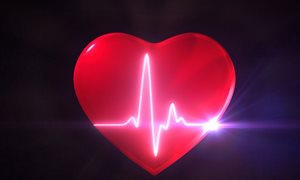
Patients with chest pain not caused by a narrowing of the coronary arteries often do not know the cause of their symptoms. Scientists at the Radboudumc have successfully used a new technique to investigate other causes in the coronary arteries of the heart. For this, they do not inject drugs into the heart, but use water.
Chest pain is often the result of narrowed coronary arteries. According to the Heart Foundation, more than 10 thousand people are hospitalized with this complaint in the Netherlands each year. They require a cardiac examination using a catheter: a tube that is guided to the heart through a vessel in the wrist or groin. Using a measuring wire, researchers can then take measurements of the heart and coronary arteries.
In some people with chest pain, such a narrowing cannot be found with a catheterization. Often their symptoms can be explained by an abnormal function of the coronary arteries, such as a cramp or spasm, or a reduced blood flow rate. Unfortunately, it is not possible to optimally diagnose such a reduced blood flow velocity with the techniques currently available. As a result, many of these patients' symptoms remain unexplained.
Researchers at the Radboudumc have applied a new technique to measure this abnormal function of the coronary arteries more accurately. This allows them to determine it earlier and more certain.
Current method is inaccurate
Currently, tests to demonstrate the function of coronary arteries consist of two parts, in which researchers inject two types of drugs into the coronary arteries: acetylcholine to determine a contraction or spasm, and adenosine to assess structural abnormalities of the capillaries. After administering these agents, they can use a monitoring wire to indirectly measure blood flow velocity and function of the vessels.
Those current methods of measuring blood flow velocity have their drawbacks, says researcher Regina Konst, PhD, of the Department of Cardiology at Radboudumc, and first author of the study. "They are indirect, and adenosine produces unpleasant side effects such as airway contractions or a hot flush." In addition, Konst says, the accuracy of the method depends on the person performing it. In a method with many complicated steps and variables, that creates additional inaccuracy.
Measuring with water is better
The test that the Nijmegen researchers used to estimate the function of the coronary vessels is a variant of the existing measurement. But instead of using adenosine, the researchers let water at room temperature flow through the coronary arteries at a fixed speed. "Because the water is colder than blood, the capillaries also open up. With a special catheter, we can then determine the blood flow rate in the coronary arteries."
With this new technique, heart researchers can for the first time determine the amount of blood flowing through the coronary arteries in an accurate, direct way. In addition, the technique is easier, so it is less important who performs the test and in what way. But the biggest benefit lies with the patient, says Konst. "Water has fewer side effects than drugs, so it is safer. This test can be done on all patients, regardless of their condition or medications they are taking."
Diagnosis provides direction
Patients undergoing this type of test often have longstanding symptoms, says Peter Damman, interventional cardiologist at Radboudumc. "Chest pain is a huge disease burden. Patients often worry, are afraid they will have a heart attack. But with the old method, it's not possible to accurately determine where the symptoms are coming from." This new method makes it easier to diagnose these heart patients as well. That provides direction, Damman says. "It is also a relief for the patient to know what is going on in his or her body."
Publicatie in Journal of the American College of Cardiology
Absolute Coronary Blood Flow Measured by Continuous Thermodilution in Patients With Ischemia and Nonobstructive Disease. Regina E. Konst, Suzette E. Elias-Smale, Dario Pellegrini, Mariëlle Hartzema-Meijer, Bas J.C. van Uden, Tijn P.J. Jansen, Priya Vart, Helmut Gehlmann, Angela H.E.M. Maas, Niels van Royen, Peter Damman. DOI: 10.1016/j.jacc.2020.12.019.
Related news items

AI helps the defibrillator think
4 October 2021 In the future, the AED and the defibrillator will be able to do more than they do today. Now the devices can only give patients who need to be resuscitated a shock, but in time it will be possible, with the help of artificial intelligence, to say more about the condition of the patient. go to page
Experts call for urgent action to reduce global burden of cardiovascular disease in women by 2030
17 May 2021 There is an urgent need to address this, states the international Lancet 'Women and Cardiovascular Disease' Commission go to page
Pregnancy complications and early menopause affect cardiovascular disease in women
9 February 2021 A number of specific conditions in women are important in their risk of cardiovascular disease. These include high blood pressure during pregnancy, gestational diabetes and early menopause. go to page
Cardiac function in relation to myocardial injury in hospitalised patients with COVID-19
16 July 2020 In Netherlands Heart Journal RIHS researcher Frederik van den Heuvel described that in hospitalized COVID-19 patients, COVID-19 predominantly affects the respiratory system, while cardiac dysfunction occurs less often. go to page
More than 350 festival attendees learned CPR during the Lowlands Saves Lives trial
26 August 2019 During the 2019 Lowlands music festival, the Lowlands Saves Lives trial was performed by the department of Cardiology. The study was a huge success as over 350 participants were randomized and learned to perform CPR. go to page
